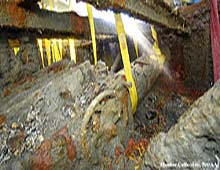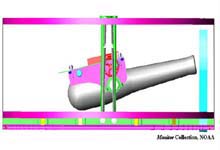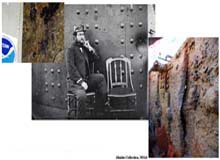
Here, the turret's cannons are visible. Excavation of the cannons begins this week. Click image for a larger view. Click image for larger view and detailed explanation.

A graphic representation of the cannon from the turret's portside. Click image for a larger viewClick image for larger view and detailed explanation.

On July 9, 1862, the Monitor's commander, Lt. William Jeffers, posed next to the turret and one of the deepest indentations in any of the photos taken that day. The photo at the top left shows what is probably this same dent. The image on the right shows how severe the damage really was. All eight layers of armor plating are dented through, and the nut guard is bent away from the turret bulkhead. Click image for larger view and detailed explanation.
Excavation of the Turret Begins
August 23, 2002
John Broadwater and
Michelle Fox
Monitor National Marine Sanctuary
On Monday August 26, scientists from NOAA and The Mariners' Museum will begin excavation inside the Monitor's turret. They will be joined by Eric Emery, an archaeologist from the Army's Central Identification Laboratory - Hawaii (CILHI), who participated in the expedition this summer. He will assist us with the human remains inside the turret.
The turret currently sits submerged in chilled water inside a specially-built steel conservation tank at The Mariners' Museum. The turret is suspended within the "spider" and platform assembly that was used to raise from the seabed. The tank is designed so that the water can be drained quickly, as necessary. The tank is fitted with two portholes to allow visitors to view the turret inside.
All of the structural elements within the turret are intact and none have been removed. The four gun slides, two vertical stanchions and two sets of horizontal braces are exposed, as are both roof hatches. The bases of both gun carriages are exposed along with the muzzle ends of both guns. Partially exposed artifacts include implements for working the guns, large and small cordage, cloth, and human remains.
While inside the turret, the archaeology team will conduct initial mapping of its contents. Although most details of the turret can be found in available historical records, numerous questions related to the structure, the working of the guns, and life aboard the ship may be answered through careful documentation and analysis of the turret's contents. All contents will be excavated, with special consideration for the human remains. The cannons and carriages eventually will be removed, but that will not be possible until the top of the "spider" assembly and the gun slides are removed.
Work will continue daily throughout the week and thereafter, as necessary, until the turret is completely excavated.
Sign up for the Ocean Explorer E-mail Update List.

































